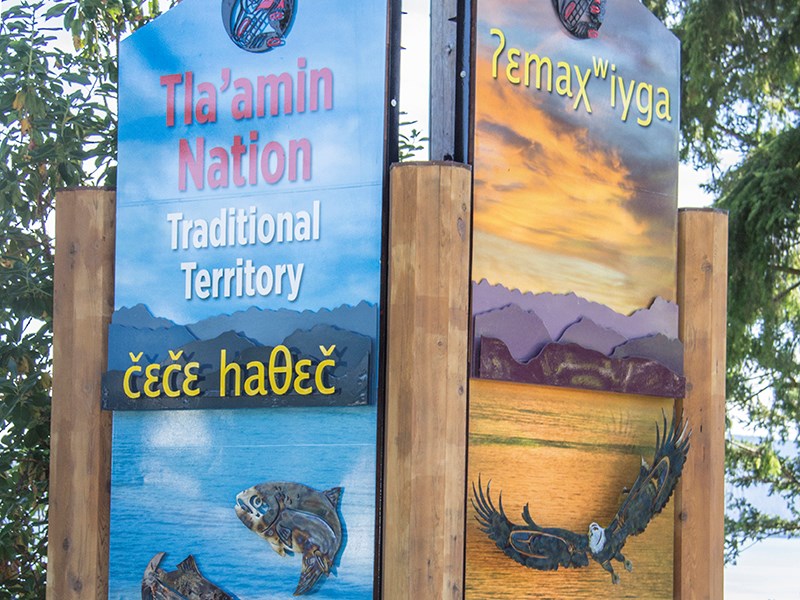New gateway signs have been installed that create a welcoming portal to Tla’amin Nation traditional lands and Powell River region. The pillar-like signs are set on either side of Highway 101.
“The gateway signs are the most recent and most highly visible of the regional signage-renewal project,” said Ann Nelson, one of the individuals who helped spearhead the idea with Tourism Powell River, Powell River Regional District and City of Powell River.
The signs are more than highway markers that indicate arriving or departing a place. They are 16 feet tall and are like postcards that depict a sense of the area, according to Nelson, who is the treasurer of Tourism Powell River’s board of directors.
Both Tla’amin and English languages are used. Tla’amin’s symbol of the bear and the Powell River city logos have been incorporated. Striking images of salmon, orca, heron and eagle stand out against backdrops of landscape, sunset and blue water.
The signs were not done with a brush and a can of paint, however. The latest technology was used. Actual photographs were printed on metal, creating a shiny, reflective surface.
The animal images were first drawn by Haida artist April White. Metalwork sculptor Peter Elvy, a blacksmith and retired welder from the Powell River mill, used a plasma cutting table to make pieces of steel plate. Those were then mounted on the backgrounds to create a three-dimensional effect.
The gateway was one part of the signage project agreed on by the city, regional district and tourism.
The newest signs are at Powell River and Lund with Texada Island pending and have a “consistent visual identity and a consistent aesthetic,” said Nelson.
According to Nelson, kiosks at Little River and Saltery Bay ferry terminals were also put up last year. The kiosks, such as the new maps at the Millenium Park trailheads, are made of cedar and maps using the newest technology of graffiti-resistant, digital printing.
At the same time as the new gateway portals were being completed, eight grade 11 students at Brooks Secondary School were creating signs as part of a program to increase access to skills and trades training.
They had an assignment to refurbished signs in a short period of time that identified areas of Tla’amin lands, including signage going into Tla’amin, a reconditioned sign for the Sliammon salmon hatchery, out at Lund and around the Townsite neighbourhood.
One of those is at Marine and Lund Highway and reads, in part, “Welcome to Tees Kwat Big River (Powell River); In honour of our elders and ancestors.”
According to the program’s teacher, James Hanson, skills building was one part of the student initiative at Brooks.
“It was to lead them through the process of actually planning a project,” said Hanson. “I was really trying to lead them through a full project development idea of getting them to understand that things don’t just happen by themselves. You’ve really got to plan what was needed.”
Just as Nelson said the new gateway portal gives area residents a sense of “our pride in where we live and our desire to share that with visitors,” the students also found a sense of pride through their project.
“Every time they go by those signs, it’s a reminder of what they’re capable of doing,” said Hanson. “It gives them a sense of self.”



